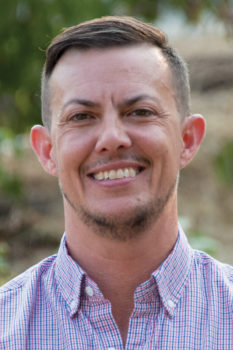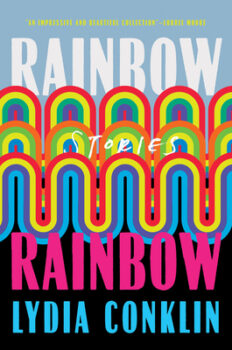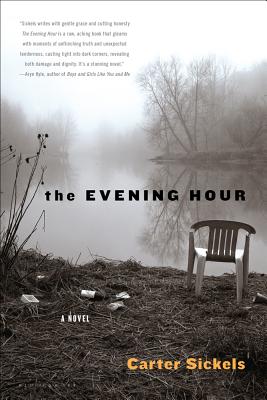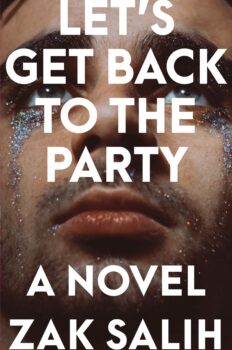I kept hearing about Carter Sickels before we met. We were both living in Portland, both writers, both queer, and we had a kind of blind date at AWP Seattle—a lifetime ago. His first novel, The Evening Hour (Bloomsbury), set in West Virginia on coal-exploited land, had come out in 2012, and I’d read it breathlessly. The outsider characters, the sharp sense of place, the subjective sense of what is right or good—reading Carter’s work reminded me of why I love fiction. Whole worlds sprang from memories and objects, and otherwise hazy emotions were distilled on the page.
I don’t remember a lot about AWP that year, other than the usual cocktail of cocktails, small talk, and book fair. But what stands out is a long winding walk through the city with Carter. There is a rare and particular joy in convergence; being with Carter was to linger where queerness and story meet, where growing up in places that rarely make the page is all the more reason to write about them. His work is about home and identity and family, and the way that our homes of origin can hold us even as they fail us.
I read his new novel, The Prettiest Star (Hub City Press), with that same sense of exhilarating resonance that I first encountered with The Evening Hour. The Prettiest Star is the story of Brian, a young gay man and artist who moves to New York, only to return a few years later because he is dying of AIDS, and the ways that his homecoming rocks his family and his small Ohio town. We spoke over email and the phone; I was at home in Washington state and Carter in Kentucky. Six years later, talking to him still feels like a long walk through a city at night, when the small talk is over, and you hope the night has so much longer to go.
Interview
Megan Kruse: I know that you have many places you call home: you grew up in Ohio, earned an MFA at Penn State, and received a Masters in Folklore at UNC Chapel Hill. You’ve lived in New York and in Portland, and now you teach in Kentucky. Both of your novels are so grounded in place, and they grapple with rural-urban tension, the small town versus the big city. Is that theme in your work something you feel in your every day?
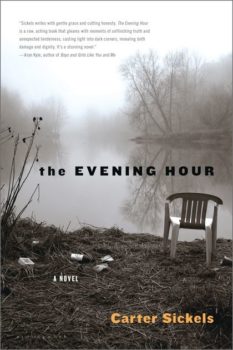 Carter Sickels: I’ve felt this more urgently at different points in my life, but, yeah, I think I’m wired with that tension. When I was writing The Evening Hour, which takes place in the mountains of West Virginia, I was living in New York City, and I missed trees and starry night skies. West Virginia was not my home, but the place felt close, familiar—on my research trips, the people I met, their way of speaking, even the landscape, reminded me of the best parts of home. But the tension was always there too: as a queer person, it’s difficult to feel fully myself or even safe in in rural spaces.
Carter Sickels: I’ve felt this more urgently at different points in my life, but, yeah, I think I’m wired with that tension. When I was writing The Evening Hour, which takes place in the mountains of West Virginia, I was living in New York City, and I missed trees and starry night skies. West Virginia was not my home, but the place felt close, familiar—on my research trips, the people I met, their way of speaking, even the landscape, reminded me of the best parts of home. But the tension was always there too: as a queer person, it’s difficult to feel fully myself or even safe in in rural spaces.
When I moved to Portland, I found myself in a dream, a city with towering Douglas firs, a vibrant queer community, and nearby mountains. While I was living there, I started writing The Prettiest Star, about a small town in Ohio, and thinking about the place I came from. I think this is common, especially for writers: yearning for one place while you’re living in another. But I didn’t want to write this story from only a place of nostalgia; I think I was trying to understand or at least to recognize all the uneasy, contradicting feelings we can have about a place, especially one we call home. Brain is an out gay man, but in this small town he’s pushed back into the closet. I wanted to explore how complicated and fraught a homecoming story can be for queer people.
As I get older, I’m less attached to this idea of home as a single space, and I try to envision home as something more expansive, more queer.
I love the idea of queering the concept of home, making it expansive. Growing up queer in a rural place, I always felt keenly aware of the idea that I must leave—that there was a “real” life out there, a whole life, waiting for me, even as it hurt so badly to imagine leaving. I see more and more queer presence in rural spaces now; I wonder if that narrative is still relevant in the same way that it was for you and I, and the way it is for Brian.
I grew up in a small town in the 80s. I had no language for queerness, and there was no queer visibility or representation. Later, in college, after I came out, I associated queer life with cities and college campuses; in rural spaces, queers were killed. I was in my 20s when Matthew Shephard and Brandon Teena were murdered, and the image of a queer person left to die in a rugged, rural, beautiful place imprinted deeply in my mind, made me afraid of those spaces. But I also missed those spaces, and I wanted to hear stories about queer and rural joy and survival.
 I agree with you about the current representation of queer presence in rural spaces—there is more of it, and it’s exciting. There is a fantastic oral history project-turned-podcast called “Country Queers,” run by my friend Rae Garringer. For years they’ve been documenting queers living in rural spaces and small towns across the U.S. There is a lot more conversation around rural queer lives, but still such a hunger and need for these stories.
I agree with you about the current representation of queer presence in rural spaces—there is more of it, and it’s exciting. There is a fantastic oral history project-turned-podcast called “Country Queers,” run by my friend Rae Garringer. For years they’ve been documenting queers living in rural spaces and small towns across the U.S. There is a lot more conversation around rural queer lives, but still such a hunger and need for these stories.
Even with more visibility and documentation, the struggles that queers living in rural places face are immense. It can be difficult to find community. There aren’t queer, safe places to meet up; there’s limited access to healthcare. Religion is everywhere, entrenched in the home, the community, the public schools. Many of my young queer students struggle with coming out. They’re terrified of losing their church, their parents’ love. That’s why these stories about queer-rural intersections, and all their layers of oppression, joy, complexity, are essential.
The biggest tension in your novel is that Brian has come home to die, and brought with him his sexuality and his vulnerability, the inexorability of AIDS in the world. Yours is a novel about AIDS at the beginning of the crisis, and over thirty years later there are still few narratives that address the AIDS crisis. What made you want to add your voice to this canon? What major influences shaped your work?
When I started writing The Prettiest Star, I wasn’t thinking about adding my voice to the canon of AIDS literature—that would have paralyzed me. I wanted to write this story about a young queer, HIV-positive man who returns to his small town in the ’80s, when panic and fear of AIDS, and blatant homophobia, loomed over everything. I wanted to tell that story partly to pay tribute to all the queer people who lost their lives to AIDS, but also to interrogate how AIDS is such a part of our cultural memory. It’s a part of queer identity and American history, and still this country has not reckoned with all the pain and harm of that time.
Novels and memoirs about AIDS that were published closer to the time of the crisis in the ‘80s and ‘90s had a profound influence on me. I first read these books back in the ‘90s, when I was coming out. Michael Cunningham’s A Home at the End of the World and Sarah Schulman’s Rat Bohemia are character-driven stories about queerness and family that capture the political and social details of the time period. Mark Doty’s memoir Heaven’s Coast is a stunning exploration of grief and love. Fenton Johnson’s Scissors, Paper, Rock is one of the only novels I’ve read that explores the AIDS epidemic in a rural landscape.
I think we’ll continue to see work that reckons with the AIDS crisis of the ‘80s and ‘90s—about New York City and San Francisco, and other places too, because AIDS affected all of the U.S (and across the world, too, but I’m speaking here specifically about the AIDS crisis in the US). Recently, there was Rebecca Makkai’s The Great Believers about the AIDS crisis in Chicago, and Paul Lisicky’s gorgeous memoir Later, about Provincetown during the ‘90s. There are still so many stories, past and present, waiting to be told, and AIDS is still ravaging vulnerable populations, especially across the South and in rural America.
Secrecy—and the shame that drives secrecy—is a force in the lives of your characters. Sarah Schulman talks about familial homophobia, how families or groups bind together against the perceived threat of queerness. You show this happening in Brian’s hometown, but you also show the experience of homophobia and fear as quite lonely. The different members of Brian’s family do not come together so much as they drift completely apart. How do you find reserves of empathy for your characters in their worst moments?
 Sarah’s book The Ties That Bind and her work on familial homophobia have been very important to me in my own life and in my novel. I was thinking about how families abandon their queer children and the deep harm this causes. Familial homophobia does not necessarily mean disowning your child or physical violence; it can work in more subtle and insidious ways, like never inviting the partner to family events. The silence and denial damage the queer child, but I believe also can break apart the family. I love how you describe the Jacksons as drifting apart, their loneliness. That was something I wanted to evoke—that they are a unit, and yet so alienated from each other.
Sarah’s book The Ties That Bind and her work on familial homophobia have been very important to me in my own life and in my novel. I was thinking about how families abandon their queer children and the deep harm this causes. Familial homophobia does not necessarily mean disowning your child or physical violence; it can work in more subtle and insidious ways, like never inviting the partner to family events. The silence and denial damage the queer child, but I believe also can break apart the family. I love how you describe the Jacksons as drifting apart, their loneliness. That was something I wanted to evoke—that they are a unit, and yet so alienated from each other.
I try to write from a place of empathy—it’s the only way for me to write complicated, fully realized characters. Empathy isn’t the same as likability. I’m not interested in “good” characters, but I also don’t want to write from a stance of judgment. Places of true vulnerability and shame are where characters become the most compelling. With Brian’s mother, Sharon, I wanted to write into that messy place of pain, prejudice, fear, love, shame—for readers to feel angry with her, but still worry for her, understand her grief. I wanted to find her humanity and show her failures. Authors who I turn to again and again—Toni Morrison, Carson McCullers, Michael Cunningham—all give their characters this incredible humanity because they’re writing about their characters’ complicated emotional journeys.
There is a fantastic writing prompt from Grace Paley that I’ve assigned to my students and tried myself: “Write a story, a first-person narrative in the voice of someone with whom you’re in conflict. Someone who disturbs you, worries you, someone you don’t understand. Use a situation you don’t understand.” On the surface, it may sound like a simple prompt, but it’s truly challenging to step into someone else’s shoes.
I was struck, too, by the way that Brian builds a community around him. Queers are so good at building community! That’s one of the really beautiful things evidenced in your book—the images of people taking care, carrying each other through.
Thank you. One of the novel’s primary questions is: How do we take care of each other? Will we extend our compassion, treat each other with dignity and respect and love? Brian’s now living with his biological family, but I didn’t want to completely isolate him from his queer family. Queers are so good at building community. Queer people understand what it feels like to be rejected—I think this is something even queer people who have good relationships with their families of origin understand. Chosen family is a part of our queer collective identity. Queers have always been creating and redefining families. In the 1980s and 90s especially, queer community members stepped up to take care of their friends and lovers. The TV show Pose, which I love, is about the ballroom culture in New York in the 90s, and beautifully captures the necessity and the fullness and possibility of queer family.
In The Prettiest Star, Brian finds a queer family in New York, and he loses many of those friends to AIDS, but his best friend Annie makes trips from New York to visit Brian in Ohio. Brian also becomes friends with Andrew, a gay man who never left home and works at Sears at the mall. Andrew is one of my favorite characters. He steps up to be one of Brian’s caretakers, and with Andrew and Annie, and a few members of Brian’s biological family, Brian builds another vital family. Andrew tells Sharon, “This is the only thing we have to do. Take care of him.”
I love that moment, the way that Andrew is holding Sharon’s hand in a way that she doesn’t deserve, but desperately needs. Brian’s evolving relationship with his mother, Sharon, feels central to the book—second only to his relationship with his sister, Jess. I have always been captivated by sibling relationships; siblings are witnesses to the part of your life that belongs otherwise only to your memory. That witnessing is heightened because we know Brian is dying, and it feels like there is an exchange happening—he is giving her his music, his art; she is coming into her body as Brian’s strength slips away.
 I’m a sucker for a good sibling story. They seem to show up more often as children stories, but adults need these stories too. I knew early on I wanted to write about Jess and Brian’s relationship, and when I first started the novel, I considered only writing from their perspectives. One of the first scenes I wrote was from Jess’s point of view, when Brian walks in the door—trying to imagine what that would feel like, for your big brother, someone you idolized but don’t really know, to come back into your life after six years. When he comes back, shrouded in secrecy, he’s a stranger to her; yet, some of her earliest and richest memories include Brian and his artful and beautiful way of seeing the world.
I’m a sucker for a good sibling story. They seem to show up more often as children stories, but adults need these stories too. I knew early on I wanted to write about Jess and Brian’s relationship, and when I first started the novel, I considered only writing from their perspectives. One of the first scenes I wrote was from Jess’s point of view, when Brian walks in the door—trying to imagine what that would feel like, for your big brother, someone you idolized but don’t really know, to come back into your life after six years. When he comes back, shrouded in secrecy, he’s a stranger to her; yet, some of her earliest and richest memories include Brian and his artful and beautiful way of seeing the world.
I love what you say about this exchange between them. Some of that showed up unconsciously in the writing—just by inhabiting these characters, writing them in scenes, trying to understand their emotional journeys. But as the novel developed, I paid closer attention to their dynamics and how I could convey their relationship. There’s a scene toward the end of the novel where I was thinking very much about the physical changes between them, but also their connections: what will Brian leave Jess, what can she do for him? In this moment, Jess helps Brian sit up and look at the window, and then later she picks up his camera.
The way that Brian’s parts of the story are told through the lens of the video camera is a concrete reminder of how many young men were lost—how many young artists, along with everything they would have created.
Brian’s video diaries took some time to construct. In early drafts, before I knew he was a video artist, I structured his sections as (written) journal entries, but they came across as flat, too narrow. I wanted Brian to be an artist, but it wasn’t until about two years into the writing process that I landed on him as a video artist. From a character development and time period perspective, this made so much sense; Brian hung out in the East Village, and he would have been exposed to the thriving downtown art scene. In the mid-80s, video cameras were still new and becoming very popular. At every holiday, there was always some dad or uncle carrying a big VHS camera on his shoulder, trying to get Grandma or a nephew to wave at the camera. The mobility and affordability of the video camera also gave artists access to another medium, and many queer artists in particular turned to video as a way to document their lives and experiences, which so much of the country wanted to ignore.
When I was researching video art and queer life in New York, I came across the video artist Nelson Sullivan, who died in 1989 and recorded over 1,800 hours of VHS footage of his life, friends, and the downtown New York scene. These beautifully queer videos helped me think about Brian as an artist and videographer, and reminded me why it’s critical to document queer lives and experiences. On a craft-structural level, the video diaries allowed me to create a frame for Brian’s sections, to set his sections apart from the others. The diaries also provide Brian with a way to control his own story.
Brain captures so many details of his old home on video, and throughout the novel you include details that evoke time and place in powerful ways. Tell me about the role of pop culture in your work. Do you worry about getting it “right”? On a craft level, how do you choose which pieces of ephemera to include?
The physical landscape and sense of place always draw me in, and for this novel, I also needed to capture the time period. Since I grew up in the 80s, I could mine my own memories—all the hours I spent watching TV or listening to the radio or making mixed tapes! But I also researched the era, making lists of popular songs, TV shows, movies, slang, clothes, objects—like the Trapper Keeper, do you remember those? I love this part of the process, the digging and compiling, and collecting inventory. I wanted to include these details to create texture and evoke authenticity without turning it into a catalogue of nostalgia. I hope the pop references—to Madonna, or watching The Brady Bunch—don’t draw attention to themselves, but work naturally in the narrative, and capture this time and place, the mood.
I’m always encouraging my writing students to use specific details, but what can sometimes get lost in that conversation is the art of relevancy. You’re not just piling on details, but searching for the significant, revealing ones—that particular detail that lights up a scene or a character.
I can’t help but read the book now through the lens of our current world: young queers going home to quarantine in the towns they thought they were leaving behind; the failure of our country to change public health in a meaningful way; the loneliness of death. This is a big question, but how do you think we should reckon with our pasts? As writers, as people?
These are hard things I’m thinking about too, and this is such an urgent question. I do believe literature and stories and art can show us other possibilities, better ways of living, of loving, of being. We need to keep telling stories and listening, especially to those stories that too often don’t get told or don’t get heard, those “hard stories” as one of my writing heroes, Dorothy Allison, says. She warns us not to “gloss over the difficulties and rewrite the horrors. Don’t make it all easier than it is and soften the tragedies.” We must reckon with our own silences and shame, our complicity.
It’s hard not to feel paralyzed by despair and worry right now. I’ve been returning to the writers who have empowered and challenged and inspired me. Audre Lorde said that our silence will not protect us, and we must always write the truth, as scary as that is: “The transformation of silence into language and action is an act of self-revelation, and that always seems fraught with danger.”
We need to keep telling stories and speaking out, and we need to take direct actions. Right now, we’re in the most consequential, momentous election of our lives—for this country, for the planet. We have to get Trump out. We can’t just wish for this to go away. Maybe we make those phone calls to voters in swing states, or donate our money or time. Will it be enough? I don’t know. But we’ve got to protest and resist and show up. Draw strength from our queer ancestors and queer art. Take care of each other. Survive.


